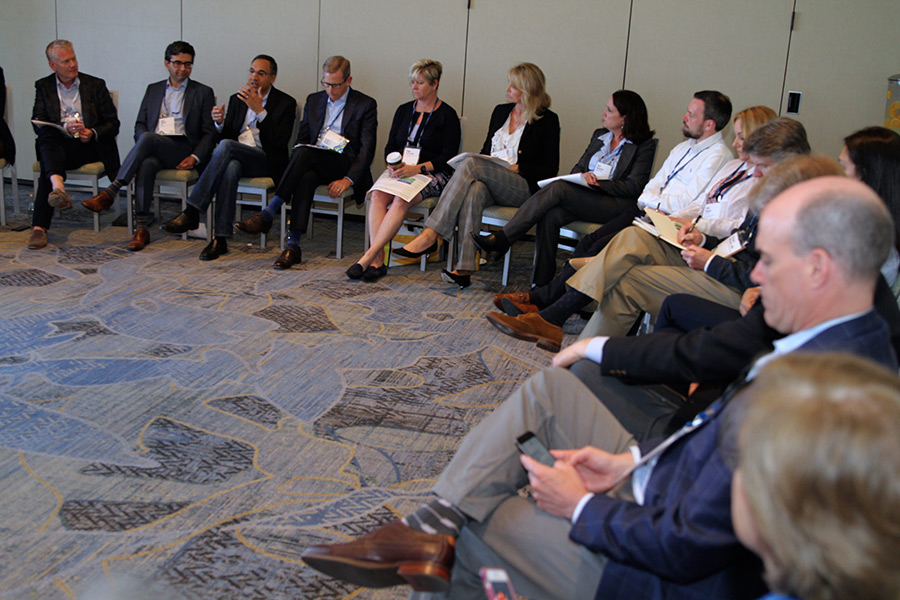Moving chronic care management into the home necessitates weaving together tools and models for fragile patients and the people who have the most significant needs in communities.
“Without a doubt, this is the time to really be able to focus on home–based care in ways we haven’t thought of before,” said Hal Paz, MD, CEO of the Ohio State University Wexner Medical Center, and a Forum Senior Fellow.
To address that as well as pre- and post-pandemic issues, the Health Evolution Forum, consisting of nearly 200 provider, payer and life sciences CEOs, has preliminarily identified the following areas of focus that are critical to advancing new models of care delivery:
-
- Leveraging value-based payments to increase health care value and resilience
- Reinventing primary care and preventative care models
- Advancing innovative home-based chronic care models
This piece, the final in a three-part series, examines value-based payments and previous articles delved into reinventing leveraging value-based payments and reinventing primary care.
Part 1: Why CEOs should leverage value-based payments to increase resilience
Part 2: Reinventing primary care: CEOs are leading the change
Advancing innovative home-based chronic care models
Health Evolution Forum’s preliminary survey data, in fact, reveals the follow areas hold the most potential for improving home-based chronic care:
-
- Remote patient monitoring: 91%
- Direct-to-to-home patient-physician telemedicine visits: 73%
- Full on “hospital in the home” models: 55%
- Home visits by PCPs, specialists, advanced practitioners: 45%
- At-home treatments list IVs and nebulizers: 36%
The broad challenge for many health care enterprises will be aligning home care with value-based reimbursement across the health ecosystem including engaging and rewarding consumers and their families for participating in new models to create better outcomes for those people with chronic disease and illness.
“That requires both a multi–organizational approach and that you not lose sight of whatever core trusted relationships exist in a community,” said Iyah Romm, CEO and Co-Founder, Cityblock, and a Forum Senior Fellow. “They have a relationship somewhere just by definition of their chronic disease, but it may not be in the traditional places that we think of for primary care delivery.”
As the head of an organization operating in that space, Romm continued that Cityblock is seeing a significant groundswell of focus on how to support people who are medically and socially fragile.
OSU’s Paz added that it’s not necessarily up to any individual organization to master all of the above.
“I don’t think that you have to own all the pieces of this. You don’t have to own the physicians. You don’t have to own the hospitals. You don’t have to own the health plan either,” Paz said. “If you have those things and there are opportunities to bring them together and make for a seamless strategy to connect them together, that’s great. But I think there are opportunities to partner.”
OSU Wexner, for its part, aligned with One Medical to more effectively coordinate care by establishing with Paz described as traditional bricks and mortar primary care that works directly with employers to drive care into the home.
Read more: Four primary care disruptors discuss retail, COVID-19 and more
Rather than every organization undertaking the work of transforming health care on its own, UCSF CEO Mark Laret, a Forum Senior Fellow, explained the importance of building a shared imperative for advancing new models.
“We need to always reinforce why we’re trying to move toward population health, improving quality of care, the health and wellbeing of the citizens and reducing costs,” Laret said.
Laret added that he envisions a future where health systems can “rent capabilities,” such as palliative care or real-time behavioral health coaching in a more cost-effective manner than developing them in-house.
“That is going to require a re-thinking away from the model that each of us has to do it on our own to maybe [a scenario where] each of us is a part of a cog in a machinery that gets the job done,” Laret said. “It just takes such scale to develop sophisticated mechanisms, to manage populations at the level that we all need to manage them. Most organizations just don’t have that scale.”
Conclusion
During August, the Health Evolution Forum ratified Work Groups to address each of the three critical action areas outlined above. CEOs and other participants will identify best practices already being used successfully in the industry and then disseminate them across the industry.
Forum Fellows and leaders, in turn, are committed to both employing those practices and advocating that their peers do as well.
“When we talk about social, behavioral, environmental determinants of health, this is where the impact is the greatest,” Paz said. “We all know that health care, per se, probably influences about 20 percent of that pie — and the remainder of the balance is really a lot of other things that, quite frankly, in the traditional approach are difficult to get our arms around.”











